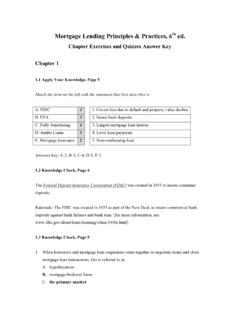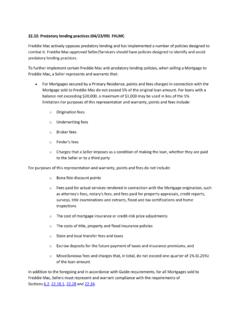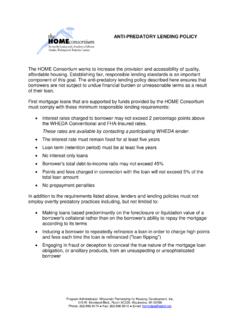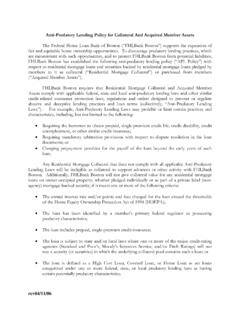Transcription of Predatory Lending Guidelines - Pennsylvania
1 Unlawful DiscriminatoryPredatory Lending andReverse RedliningGuidelinesIn Housing andCommercial PropertyPrepared by thePennsylvania Human Relations CommissionPurpose of GuidelinesIn proposing these Guidelines , the Commission has set forth factors that it considers to beimportant in determining whether, in any given case, a party has engaged in unlawful predatorylending and/or reverse redlining based on race, ethnicity or other protected classification in violation of Section 5 of thePHRA. In so doing the Commission reiterates its longstanding position that these Guidelines are not intended to be hardand fast rules that must be absolutely applied. They are intended to provide guidance and assistance to those who comeunder the jurisdiction of the Commission as it continues its effort to insure that the right to equal housing and commercialproperty opportunity as set forth in the PHRA is in these Guidelines shall affect statutory or regulatory requirements. The Guidelines are not anadjudication or a regulation.
2 There is no intent on the part of the PHRC to give the Guidelines that type ofbinding force or effect. They are nonbinding Guidelines that indicate the manner in which the PHRC intends toexercise its administrative discretion in the future, unless it is convinced otherwise during the course of aspecific proceeding. The Commission, as in the past, remains committed to insuring that its adjudicativedeterminations are made on a case-by-case basis after consideration of all evidence of record in the given this end, the Guidelines are not binding and may be deviated from whenever the PHRC believes that any statute orregulation requires it, or that it is otherwise appropriate to do so. The Guidelines may not be cited as authority for anyPHRC ruling, adjudication or other binding action. The legal rationales set forth in a policy may be cited as the basis forPHRC action to the extent that the Commission believes the rationale is valid in the context of the specific Pennsylvania Human Relations Commission (hereinafter Commission or PHRC),cognizant of the fundamental guarantee found in the Pennsylvania Human Relations Act(hereinafter PHRA) that the opportunity to obtain any housing accommodation and/or commercial propertymust be provided irrespective of race, color, familial status, religious creed, ancestry, disability, age, sex ornational origin, sets forth the following Guidelines for use by those responsible for providing fair lendingopportunities or otherwise involved in the Lending of money and/or real estate-related transactions within theCommission s jurisdiction.
3 Those responsible for providing fair Lending , include, but are not limited to, thefollowing: lenders; mortgage brokers; appraisers; loan servicers; title companies; home improvementcompanies; state and local government agencies; and all others involved, whether directly or indirectly, in the mortgageloan process or home finance Commission, in proposing these Guidelines , recognizes that all persons are entitled to fair access to creditand the ability to share in the American dream of homeownership. The Commission further recognizes that fairaccess to credit in housing and commercial property requires the elimination of the policy or practice ofengaging in unlawful discriminatory Predatory Lending and/or reverse redlining based on race, ethnicity or anyother protected class. The Commission, also, recognizes that action or inaction, whether direct or indirect, overtor covert, which fosters unlawful discrimination or segregation in the area of housing and/or commercialproperty, including but not limited to, unlawful discriminatory Predatory Lending and reverse redlining based onrace, ethnicity or any other protected class is contrary to the public interest.
4 Whenever any such action orinaction adversely affects housing and/or commercial property transactions within the Commission s jurisdiction, it is theobligation of those responsible for providing fair Lending to correct the situation.(Adopted by the Pennsylvania Human Relations Commission on June 27, 2005)Unlawful Discriminatory Predatory Lending and ReverseRedlining Guidelines In Housing and Commercial PropertyReverse Redlining as a Violation of the PA Human Relations ActRedlining is the practice of denying credit to specific geographic areas due to race, ethnicityor some other protected class of its residents. In contrast, reverse redlining is the practice ofextending credit on unfair terms to specific targeted geographic areas due to race, ethnicity or some other protectedclass of its residents. Such practices lead to the formation and maintenance of racial and ethnic segregation, which theFair Housing Act and PHRA were designed to combat. Courts and the Commission have held that reverse redliningviolates the Fair Housing Act and the order to prove a claim based on reverse redlining, a complainant must show that a respondent s lendingpractices and/or loan terms are unfair and/or Predatory , and that respondents either intentionally targeted aprotected class, or that there is a disparate impact on a protected class.
5 Upon such a showing, a respondent mustdemonstrate that its loan or Lending practices are justified by business necessity. Such Lending policies and/orpractices render housing unavailable to minorities and other protected classes and subjects them to discriminatory loanterms and conditions, thereby reducing their ability to use and enjoy housing. By adopting these Guidelines , theCommission seeks to provide guidance on each of the above-noted relevant factors necessary to examine an unlawfuldiscriminatory Predatory loan and/or reverse redlining Discriminatory Predatory Lending as a Violation of thePA Human Relations ActPredatory Lending is primarily concentrated in the sub-prime mortgage Lending market in thearea of home refinancing loans. The sub-prime market is intended mainly for people who areunable to obtain a conventional prime loan at a traditional financial institution due to blemished credit historiesor some other problem. Such sub-prime lenders may charge more for their loans to compensate for thepotentially greater risks and costs associated with Lending to such borrowers.
6 In short, sub-prime lenders mayuse risk-based pricing to serve borrowers who cannot obtain credit in the prime market. The Commissionrecognizes that by providing credit to borrowers who otherwise would be unable to obtain it, the sub-primelending market may perform a significant determining whether a Predatory loan or practice constitutes unlawful discrimination and/or reverse redliningin violation of the PHRA, the Commission will evaluate the loan in the context of the totality of thecircumstances surrounding the real estate-related transaction. The Commission will examine whether the loancontains any abusive or onerous terms that cannot be justified on the basis of the lender s additional risk andcost; the suitability of the loan for the purposes and interests of the borrower; and the behavior of the parties inrelation to the transactional circumstances surrounding the loan. Furthermore, the Commission recognizes that,while Predatory Lending may violate a number of federal and state laws, these Guidelines are applicable topredatory Lending in the context of the Commission s jurisdiction within the dictates of unlawful discriminationin violation of Section 5 of the Loan Terms as a Factor in Determining Whether a Respondent HasEngaged in an Unlawful Discriminatory Predatory Lending Practiceand/or Reverse RedliningAbusive loan terms are a factor in determining whether a respondent has engaged in an unlawfuldiscriminatory Predatory Lending practice and/or reverse redlining based upon protected class membership in violation ofthe PHRA.
7 Typically, the Predatory nature of many loans is not the result of a single loan term or feature, but a series offeatures that in conjunction with each other impose substantial financial hardships on the borrower. As a result, theCommission will examine the totality of the circumstances surrounding all loan terms when there is a complaint or anallegation of unlawful discrimination. Predatory or unfair loans often include a variety of abusive loan practices, includingbut not limited to, potential abuses associated with the following:Mandatory Arbitration Clauses: A mandatory arbitration clause in a loan agreement requires, as a condition toreceiving a loan, that the borrower agree to resolve any dispute arising out of the loan through an arbitrationprocess, rather than in court, possibly limiting the ability to obtain judicial relief. While arbitration clausesare not per se abusive, they may contain terms and conditions that are abusive. For example, such arbitrationclauses may require the borrower to pay all arbitration costs, fail to specify who will pay arbitration costs, orrequire the arbitration to take place in a location far removed from the borrower s Broker Fees: Mortgage brokers may receive unreasonably high compensation as a result of inflated up-frontfees paid by borrowers and indirect fees paid by lenders.
8 A mortgage broker may not furnish any service to theborrower or the compensation may not be reasonably related to the value of the goods or services that wereactually furnished to the borrower. A mortgage broker fee in excess of 3 percent of the total loan amount may reflectabusive characteristics, if it is not justified by Amortization: In a negatively amortized mortgage, a borrower s regularly scheduled payments do not coverthe full amount of interest due, causing the outstanding principal balance to increase during the loan Payment: A balloon payment occurs at the end of a loan term when regular monthly payments do not fullyamortize the loan principal. As a result, at the end of the loan term the borrower still owes most of or the entireprincipal. Such balloon payments may consist of 85% or more of the principal amount of the loan forcing theborrower to refinance, incurring additional costs, or risk or Foreclosure Practices: A lender or servicer of a loan may utilize oppressive tactics such as harassingtelephone calls or threats of foreclosure in its efforts to obtain payments or impose unjustified or exorbitant late feesand Insurance: Typical insurance products that may be sold in connection with a loan, include: credit life; creditdisability; credit property; and involuntary unemployment.
9 Such policies typically provide coverage for the first 5 to7 years of the mortgage. A lender may charge premiums for credit insurance, which are not justified, based upon theactual loss payout or are not consistent with other applicable state laws or regulations. Furthermore, when the costof the insurance is financed into the loan, the borrower pays more than he or she would on a monthly installmentbasis because the 5 to 7 year policy is financed over the 15 or 30-year life of the : Flipping refers to the practice of repeated loan refinancing in a short period of time charging additional feesand points with little or no benefit to the borrower due to the financing of points, fees, and prepayment penalties thatmay accompany such loans. A borrower may receive modest additional funds or a slight reduction in the interestrate, however, such gains may be offset by the points and fees associated with such a Interest Rates and Annual Percentage Rates (APR) Not Justified By Risk: A loan with an APR 6 percentagepoints above Treasury securities for first liens and 8 percentage points above Treasury securities for second liensmay reflect abusive characteristics if it is not justified by the risk or cost associated with such a loan.
10 The fact that aloan has an interest rate or APR above or below such a threshold, however, is not dispositive of whether or not aloan is Predatory . Rather, it reflects a single variable to be considered in the totality of the circumstances surroundinga Improvement Scams: A contractor, acting as a mortgage broker or in conjunction with a lender, may refinance aborrower s mortgage in order to fund a home improvement project. The loan arranged by the contractor or lendermay contain abusive terms and/or the contractor s work may be incomplete or of poor Padding: Unreasonable high and/or illegitimate settlement fees and charges are charged to the borrower and arepaid with the loan proceeds thereby increasing the principal loan amount on which the borrower must pay Manner in Which a Loan Is Made as a Factor in DeterminingWhether a Respondent Has Engaged in an Unlawful DiscriminatoryPredatory Lending Practice and/or Reverse RedliningThe manner in which a loan is made is a factor in determining whether a respondent has engaged in an unlawfuldiscriminatory Predatory Lending practice and/or reverse redlining based upon a protected class in violation ofthe PHRA.









